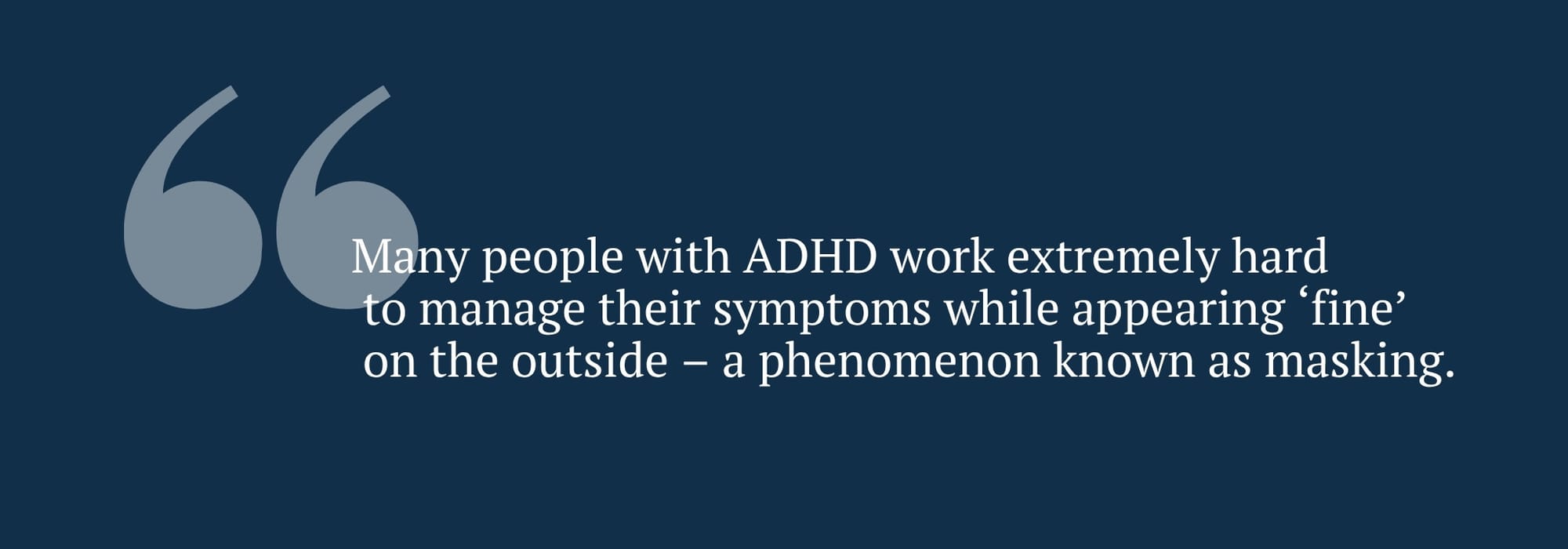Thawing misconceptions about the ADHD experience, using the iceberg analogy to explore what is below the surface…
When John* was at school, he was often berated by his parents for leaving his homework until the last minute. As he got older, John would lose his keys, his wallet, and forget deadlines. He always wondered why he couldn’t remember things – until he was diagnosed with inattentive attention deficit hyperactivity disorder (ADHD) at the age of 33. He felt validated. Deep down, he knew something else was going on and, finally, he had the answer.
Far from the tired stereotype of the child who can’t sit still, ADHD is complex. Research, such as a study in PLOS One, has shown that ADHD brains are both structurally and functionally different, meaning the condition affects people in varying ways.
When we think of ADHD, we tend to think about external symptoms, such as fidgeting or trouble focusing. And while these can be a key part of ADHD, people experience a wide range of internal symptoms too, like trouble concentrating and memory problems.
The ‘ADHD iceberg’ is both an effective way of visualising these invisible symptoms, and a tool to encourage understanding and empathy for the impact they can have on someone’s life.
What is the ADHD iceberg?
“The ADHD iceberg is a powerful analogy that illustrates how much of ADHD is hidden beneath the surface,” says Dr Rebecca Varrall, clinical psychologist and co-founder of Neurodiversity Unravelled, which works with neurodivergent families and individuals.
The tip of the iceberg represents the external symptoms of ADHD that many people recognise. But hidden beneath the water lies a much larger piece, representing the internal experiences and challenges of ADHD that many aren’t aware of.
“Only a small portion of ADHD symptoms – such as hyperactivity, forgetfulness, or trouble focusing – are visible to others,” Dr Varrall explains. “Beneath the surface, however, lies a vast array of internal struggles that go unnoticed, including emotional dysregulation and executive dysfunction.”
What are the internal symptoms of ADHD?
“Racing thoughts can mean experiencing a constant stream of ideas, making it hard to focus or fall asleep,” says Dr Varrall. “People may have emotional sensitivity, which can result in intense emotional reactions to things that others may not understand.”
Executive dysfunction, which affects the brain’s ability to plan, organise, and complete tasks even when they’re important or personally meaningful, can lead to self-doubt and feelings of failure. A busy mind can make it hard to relax, leading to exhaustion and/or anxiety.
Rejection sensitivity dysphoria is also common. This refers to the emotional pain people may experience in response to perceived rejection or criticism. People with ADHD may also have difficulty gauging time. “The impact of these internal symptoms can be profound. Struggling with tasks that seem ‘easy’ for others can lead to feelings of inadequacy,” says Dr Varrall.

Many people with ADHD work extremely hard to manage their symptoms while appearing ‘fine’ on the outside – a phenomenon known as masking. “Because they seem to be functioning well, their difficulties are often overlooked,” says Dr Varrall. “This constant effort to appear ‘normal’ can lead to stress and burnout, affecting work performance, relationships, and overall wellbeing.”
In 2023, a study of 504 people by the University of Bath, published in Scientific Reports, found adults with high levels of ADHD symptoms are more likely to experience anxiety and depression. And, like John, years of hearing about their deficiencies or challenges related to having a neurodivergent brain can lead many people with ADHD to struggle with low self-esteem.
How to cope with the internal symptoms of ADHD
Here are seven steps, tools, or support routes that can help you navigate the often overlooked symptoms of ADHD:
Explore open communication
“Talking to friends, family, or partners about ADHD can help foster understanding and support,” says Louise Lawrence, a speech therapist and co-founder of Neurodiversity Unravelled. “Connecting with other neurodivergent individuals, via online communities or support groups, can remind you that you’re not alone.”
Make adjustments at work
Discussing reasonable adjustments with an employer, such as flexible deadlines, structured check-ins, or quiet workspaces, can improve productivity and reduce stress.
Schedule a meeting with your boss to discuss your needs. It can be useful to bring a written list of what you struggle with, and what would help. For example, organisation apps like Todoist may help you with deadlines.
“You could try strategies like body doubling, which involves working alongside someone for accountability,” says Louise. “Structured routines, like allocating time periods for certain tasks, can help manage focus.”

ADHD medications
During your assessment for ADHD, your doctor may discuss whether medication would be appropriate. There are two types of ADHD medications: stimulant and non-stimulant.
During your ‘trial’ period (titration), you’ll be supported by a specialist to find the right dose for you.
ADHD coaching
“An ADHD coach helps clients develop personalised strategies for organisation, time management, goal-setting, and self-regulation,” says Louise. This kind of structured support can helping you identify specific obstacles, strengths, and ways to move forward.
Lifestyle changes
Some studies, such as 2020 research in the journal Borderline Personality Disorder and Emotional Dysregulation, suggest exercise may help improve symptoms like inattention, but, just as importantly, it can boost mood and reduce stress – as noted in a 2014 study in Frontiers in Physiology. Melatonin, herbal sleep tablets, weighted blankets, light therapy, and sticking to a bedtime routine may help improve sleep, too.

Try talking therapy
Speaking to a therapist can help you process the emotions associated with ADHD. Cognitive behavioural therapy can help people identify and modify negative thought patterns and behaviours that can arise as a result of challenging symptoms.
Learn to accept yourself
“Self-acceptance is a crucial part of living with ADHD,” says Louise. “Instead of seeing ADHD as a flaw, it can be helpful to recognise it as a different way of thinking – one that comes with unique strengths, such as creativity, problem-solving abilities, and resilience.”
Working with a therapist can help you treat yourself with compassion, as can educating yourself about ADHD. “It can provide clarity and validation, helping to replace self-criticism with self-compassion,” she adds.
*Name changed


Comments